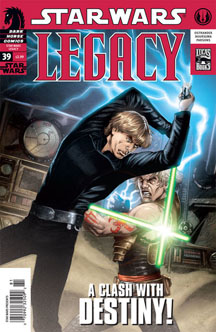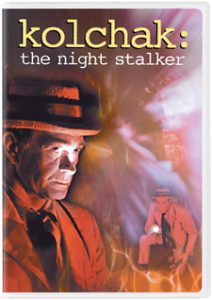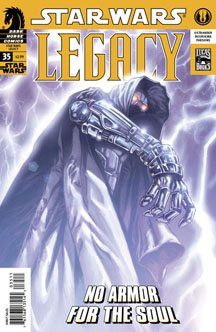George Lucas was interested in the dangers of humans melding with machines, but that concept was buried by the time he got to the final drafts of his “Star Wars” films. The machine aspects of Darth Vader and General Grievous (and Lumiya and the Hunter, if you delve into the Expanded Universe) were emblematic but arguably superfluous, because – regardless of what they looked like – their evil came from their human half, not their machine half.
“The Star Wars,” the comic adaptation of an early draft of what eventually became “A New Hope,” shows how strongly Lucas linked cyborgs with inhumanity. “There is nothing left of me but my head and right arm!” Annikin Starkiller says. Not trusting himself due to being a cyborg, Annikin asks Skywalker to take over Kane’s training. (It’d be interesting to know if Lucas’ views on the subject have changed as we move into an age where technology is extending and enhancing people’s lives – and they aren’t turning evil.)
One of the wonderful aspects of “Legacy” is that it takes the classic themes of “Star Wars” but emphasizes different elements; this is particularly apparent in Issues 32-40 (2009). In “Storms” (Issues 34-35), Cade’s Force powers and his Aunt Droo’s medical abilities allow them to save the life of Cade’s old flame, Azlyn Rae, but she’s encased in a suit that pumps bacta into her veins and breathes for her. “Sometimes I can’t feel anything at all! I’d rather be dead!” she says, and it seems Cade has inadvertently created an enemy.
Azlyn is also resentful that Cade didn’t honor her request to let her die, similar to Buffy’s initial disgust at being yanked out of heaven by her well-meaning friends in “Buffy” Season 6. Still, one wonders if being part machine might indeed enhance a person’s darker feelings. Unlike most cyborgs in “Star Wars,” Azlyn was a good person at the time of her transformation, so she might be the best outlet for exploring this theme.

But even if “Legacy” explores the tortured life of cyborgs more than Lucas did, writer John Ostrander can’t help but get back to the saga’s core family dynamic, particularly in “Tatooine” (37-40). Cade is sought by Sith Empire agent Gunner Yage, whom he doesn’t realize is his half-sister. Ostrander and artist Jan Duursema have fun with squeamish readers by having the duo almost kiss, but luckily Yage hates Cade’s guts.
Also back on the scene is Sith Empire agent Morrigan Corde, whom Cade knows is his mom, although he wants nothing to do with her due to Morrigan’s abandoning of him and his father, Kol Skywalker. Until a corrupt moff tells her so, Yage does not realize that Corde is actually her mother, too; Yage knows that her mother is Nyna Calixte, but she doesn’t know Calixte and Corde are the same person. Whew.
Setting the soap-opera drama aside for a moment, the highlight of “Tatooine” is a long dream sequence where Cade argues with the ghost of Luke, his great-great grandfather (by my calculation, although it isn’t explicitly stated), at the Lars farmstead. Luke’s warnings about Cade slipping to the dark side are smug enough that I side with Cade. But on the other hand, Luke makes a fair point, and Cade’s eyes had been getting a bit “Sithy,” as Syn put it.

Cade: “I’m not a Sith or a Jedi! I’m not like my father, or your father, or you. I just want to be left alone!”
Luke: “You’ve proclaimed who you are. But the galaxy is not going to leave you alone. Ever.”
We also learn in “Storms” that Droo is a descendant of the Clan Vos; Quinlan Vos was the protagonist of Ostrander’s “Republic” comics.
Keeping with the revelations of family ties, “Fight Another Day” (32-33) explicitly states that Emperor (of the non-Sith Empire) Roan Fel is the grandson of Jagged Fel and the third Emperor in the family dynasty (following Jag and Jag’s son). Since Jag and Jaina Solo were married at the end of the now-canceled Legends novels timeline, it’s likely that Roan is also of the Solo bloodline. So Cade’s family and Fel’s family (and Quinlan’s family) would share the same family tree if you branched it out enough.
Yet another family tie is introduced in “Storms,” as we meet Darth Wyyrlok’s daughter, who is being groomed as the fourth Darth Wyyrlok. Of all the political scheming in “Legacy,” Wyyrlok’s is the boldest: He has killed Darth Krayt, but he pretends that Krayt is in stasis on Korriban so that he may rule, allegedly by proxy. In “Tatooine,” Wyyrlok further appoints Grand Admiral Morlish Veed (Calixte/Morrigan’s husband) to serve as his regent. Thus, Wyyrlok gets to wield power without having a target on his back, making him one of the smartest villains in “Star Wars” lore.
“Fight Another Day” is an outstanding exploration of loyalty to another kind of family unit: the military. Although such loyalty is almost universally considered to be a good thing, some argue that a soldier may disobey an order if he has a moral disagreement with it. Ostrander creates a scenario where one’s moral conscience clearly must rank ahead of being a loyal soldier. Imperial Knight Sinde is on Dac as a consultant to the Mon Cal people. Because Sinde’s Fel Empire and the Sith Empire were once the same Empire, Sinde encounters several former colleagues, including one he kills in battle.
Sinde: “His crimes? Obedience and loyalty.”
Tanquar (Mon Cal rebel leader): “No, Master Sinde … his crime was genocide. … I shed no tears for him. He was my enemy. He made his choice.”
“Renegade” (36) continues to delve into the troublesome logistics of the Galactic Alliance and Fel Empire forming an alliance against the Sith Empire. Some of the military men want to win the battle at any costs, others seek to spare lives – again, orders and morality come into conflict.
Suffice it to say that the G.A./Fel Empire alliance is in place by the end of “Renegade,” so that should make for clearer battle lines among governments as “Legacy” moves forward. Meanwhile, the various families in the series aren’t so stable — particularly Cade’s, as he leaves ticked-off relatives in his wake. Luke pulled Anakin back from the dark side, but if Cade needs someone to do the same for him, who will it be?

